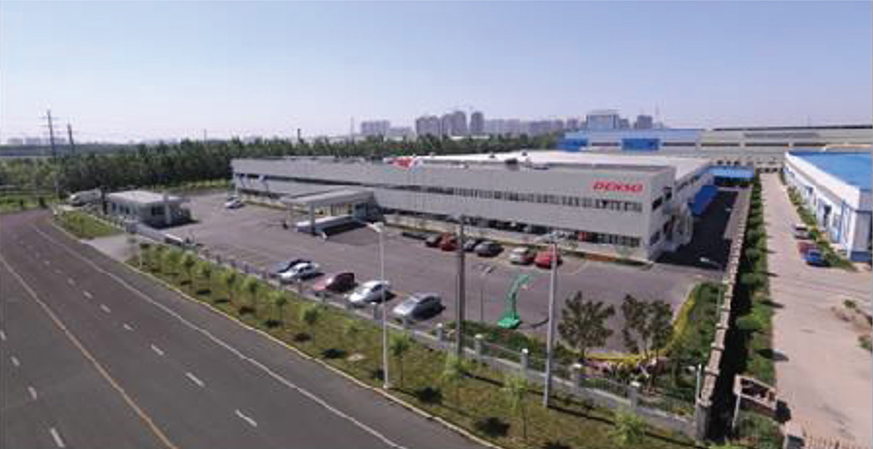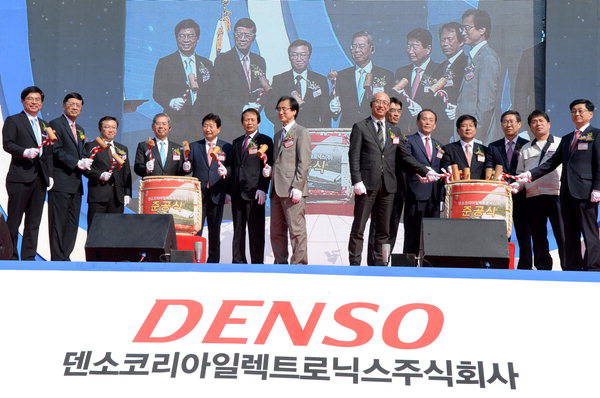2. Expansion of the automobile products field and sales growth
(2) Growth and development of DENSO PS Electronics
DENSO PS Electronics Corporation, newly established as “DENSO PS Electronics Corporation” as a result of the capital increase in DENSO equity of POONGSUNG Electric Corp. in 2000, was established in Changwon, South Gyeongsang Province in 1976. Since then, through a joint venture with DENSO, it introduced advanced part technology and grew into the country’s best and largest cluster manufacturing enterprise with the highest technological capabilities through sustained quality improvement and innovation. Park Sang Yeol was appointed as the first President & CEO, and for 10 years he managed DENSO PS Electronics, laying the foundation for its growth.
From the 2000s, the South Korean automobile market grew rapidly, and endless competition over price, quality, and customer satisfaction was inevitable. The completed-car industry focused on creating a system that could quickly supply inexpensive parts for competitiveness. In keeping with the changing times, DENSO PS Electronics placed a great deal of emphasis on sustainable technical development and improvement of production capacity, and strived to produce the best products through thorough quality control. Through weekly “CHALLENGE ZERO” activities to report Kaizen countermeasures for process defects, supplier defects, customer returns, and market complaints, and through the first, second, and third preliminary quality verification meetings for new products, only products of excellent quality were selected.
In fact, such efforts led to the creation of more than 30 in-house quality quotas and the introduction of DENSO’s quality assurance system, which is applied to all reliability tests, vehicle durability tests, and mass production tests, thereby securing a high level of quality. Then, in September 2006, the company represented South Gyeongsang Province at the National Quality Union Congress and received the President’s Award. Advanced development engineers also implemented long-term DENSO training and made every effort to secure the same level of technical competence in all sectors, including R&D, production, and technology.
In 2000s, the South Korean automotive industry also experienced significant changes amid the wave of globalization. The effects of globalization on the South Korean automotive industry were reflected in South Korea, including the expansion of completed-car manufacturers into overseas markets, the expansion of parts manufacturers, acquisitions and mergers of major parts manufacturers in the world, and a sharp increase in the export and import of parts.
Because of the characteristics of the automobile products industry that delivers parts to completed-car manufacturers, the coping strategies of South Korean automobile products manufacturers due to globalization could not help being directly affected by changes in the environment related to Korean completed-car manufacturers.
It was not different for DENSO PS Electronics. In 2004, Hyundai Motor Group, its largest customer, achieved a cumulative total of 10 million units exported, and DENSO PS Electronics began to produce real results in overseas markets, sequentially establishing local production plants in China, the Czech Republic, Slovakia, and Russia. DENSO PS Electronics promoted the establishment of mergers with DENSO companies at actual sites to ensure stable parts supply in line with Hyundai Motor’s overseas expansion.

In order to enlarge its global production system, DENSO PS Electronics established its group company in China, TPE (TianJin Poong Sung Electronics Co.) in Tianjin, China, in 2006 and began producing instrument panels. Then, in 2013, when DENSO PS Electronics Corporation changed its name to DENSO Korea Electronics Corporation, the name of group company in China was changed to DTBP (DENSO TIANJIN BODY PARTS CO., LTD.).
After 2015, DENSO Korea Electronics delivered its smart-key products to customers via Pass Through.
On the other hand, in 2013, the company established the group company in Poland, Europe, DENSO POLAND sp. z o.o. and began production of instrument panels, actively responding to globalization in the world automobile market.
After its establishment in 2001, DENSO PS Electronics began developing new products in earnest, developing stepper motors in 2002, and then developing and delivering instrument panels for Suzuki Motor Corporation and Mazda Motor Corporation in Japan in 2007 and 2008.
The instrument panel trends for major customers Hyundai-Kia Motors also changed to thin film transistor (TFT)-applied design, and in 2007, Kia Motors’ K7 and Hyundai Motor’s “Equus” were the first in South Korea to apply TFTs of 7 inches and 3.5 inches, respectively. These are cited as products that contributed significantly to the sales growth of the group companies in the Korean region.
In the 2010s, Hyundai-Kia Motors promoted “vehicular premiumization” as a sales strategy, and this led to the introduction of the “Head Up Display (HUD)” in South Korea, which was applied only in the European automobile market at that time.
Hyundai-Kia Motors determined that DENSO PS Electronics could sufficiently develop HUDs in South Korea and mass produce them. As a result, DENSO PS Electronics worked with DENSO and Hyundai-Kia Motors to develop Korea’s first Head Up Display.
In 2012, the Kia’S “K9” was fitted with a Head Up Display for the first time in South Korea. It improved driving convenience and safety and got a great response from customers.
DENSO PS Electronics also developed the first “12.3-inch full-size TFT LCD instrument panel” in South Korea in 2012 and started mass production.
A virtual instrument panel was designed using a 12.3-inch full-size display window to provide state-of-the-art information. The system’s large, full-color screen dynamically realized various content other than basic information. It was also praised for improving the driver’s satisfaction in the sense of operation by differentiating itself from existing instrument panels, with changes such as variable themes for the instrument panel and variable size of the numbers.
The application of an instrument panel with a 12.3-inch full-size TFT screen was a rare breakthrough in the South Korean automotive industry and was the catalyst for the subsequent enlargement of digital instrument panels.
On March 11, 2011, Japan’s Tohoku region experienced the largest earthquake in history, with a magnitude of 9.0. The earthquake, named the “2011 off the Pacific coast of Tohoku Earthquake”, was recorded as the fourth strongest in the world since the beginning of the 20th century. After the strong quake, a super-large tsunami struck cities including Sendai City, destroying industrial facilities along with many lives.
The 2011 off the Pacific coast of Tohoku Earthquake also caused direct and indirect damage to Japanese enterprises and had a devastating impact on automobile products plants throughout Japan. DENSO was also not immune from the effects.
At that time, DENSO PS Electronics was importing a large number of parts from Japan, so it was expected that the delivery of parts to customers would be affected if emergency measures were not taken. The 11 manufacturers with whom DENSO did business for the main parts were unable to operate properly due to power failures and other factors, making distribution difficult. As a result, the inventory that had been secured was depleted. After consulting with headquarters, DENSO PS Electronics analyzed the extent of the effects by part and made efforts to minimize the damage by securing inventory and finding replacement goods.
Then, in the fall of that year, a big flood also occurred in Thailand. Things were not as bad as they were for Japanese electronic component companies, which are common in Thailand, but the flood also hurt DENSO. DENSO PS Electronics’ sales fell more than 30% in the aftermath of the 2011 off the Pacific coast of Tohoku Earthquake. In 2012, however, the economy began to recover and regain stability.
To prepare for natural disasters such as the 2011 off the Pacific coast of Tohoku Earthquake and the massive flooding in Thailand, DENSO tried to stabilize its business by shifting its production of DENSO automobile products used in South Korea to a production system in South Korea.
In the 2010s, it became a pressing problem for DENSO PS Electronics to increase its production of instrument panels for export to Suzuki in Japan and to add production lines to produce new products for export to North America. At the same time, the company had to give priority to parts supply to Hyundai-Kia Motors, which had risen to fifth place in the world by increasing their share in the global market.
However, the site of DENSO PS Electronics’ Changwon Plant (17,490 m2), used since the early days of POONGSUNG Precision, had already reached its limit, making it difficult to expand the facility further. Plants could not withstand the increasing production volume and become old and obsolete were in a situation in which relocation was inevitable for the welfare of employees.
From 2011, DENSO Headquarters and DENSO PS Electronics searched for land in a region near Changwon to add production lines. Just then, in November 2010, the city of Changwon completed the construction of the “intelligent home industrial complex” in Usan-dong, Masanhappo-gu, and actively sought companies to move in and attract investment. DENSO PS Electronics once again had a forward-looking reaction. Because new public housing had already been built, the surrounding environment was excellent, and above all, transportation was convenient. Therefore, the intelligent home industrial complex in Usan-dong was selected as a candidate site.
In December 2012, DENSO PS Electronics signed an investment contract worth 400 billion won with Changwon City and held a groundbreaking ceremony in July 2013 after working-level discussions. The plant site in Usan-dong was 82,803 m2, about four times larger than the Changwon Plant, and the new building occupied only 45,723 m2 (total area: 58,646 m2), making it possible to expand the plant in the future.

Official occupancy began in the first half of 2014 with the relocation of the production line. The actual completion ceremony was held in April 2015, when all the relocation had ended and the production line had stabilized. The relocation to the new plant in Usan-dong also helped activate regional society by creating about 500 jobs.
The concept of the new plant was to be a “cutting-edge, environmentally friendly plant”, with a static electricity interception gate at the entrance to the production site to prevent static electricity, and functions to automatically adjust temperature and humidity to reflect the characteristics of environmentally sensitive electronic products. At the same time, light ducts were installed on the roof, and sunlight was collected from the roof during the daytime and allowed to transmit inside the factory to be used as a substitute for lighting.
With the establishment of DENSO’s new plant in Usan-dong, the name of the industrial complex was changed and officially registered from the existing “Changwon Urban Advanced Industrial Complex” to the “Gyeongnam Changwon DENSO Urban Advanced Industrial Complex” through deliberation by the Gyeongnam City Planning Commission. This event showed the effects and position of DENSO in regional society.